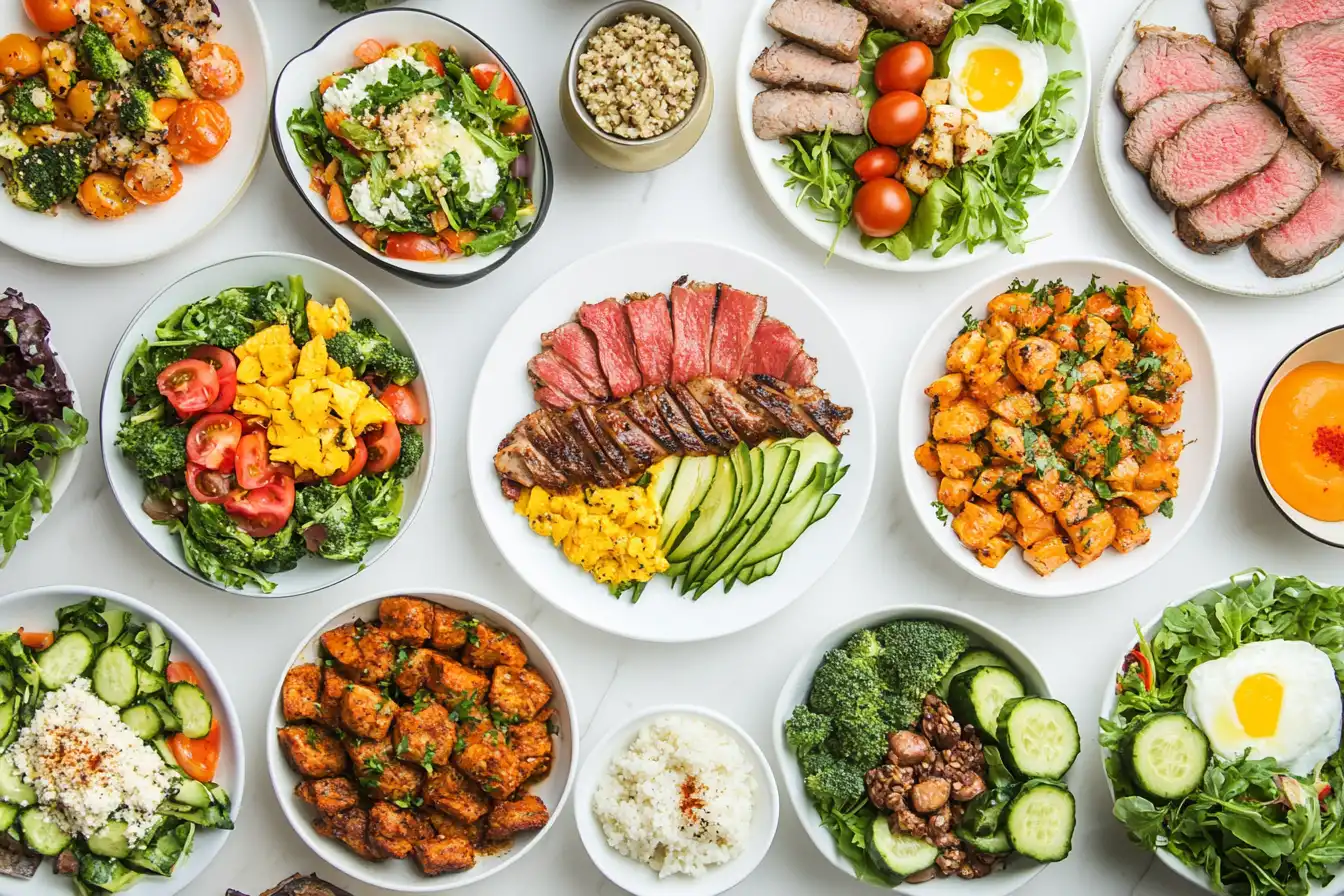Here’s a look at typical keto meals. This article explores options that help you stick to the keto diet. We’ll cover what to eat, with tasty, easy suggestions.
Understanding Typical Keto Meals and Their Basics
The keto diet, or ketogenic diet, focuses on eating foods that are high in fat, have moderate protein, and are very low in carbs. Typical keto meals revolve around this nutritional concept. This approach forces your body to use fats for energy instead of carbohydrates. The main goal is to get into a state called ketosis. Therefore, you must choose your food items carefully to maintain this.
The Basic Structure of Ketogenic Meals
Keto meals generally include a base of healthy fats, a moderate portion of protein, and very few carbs. Protein sources can be meat, poultry, fish, or eggs. Healthy fats come from avocados, olive oil, nuts, and seeds. Consequently, you need to limit high-carb items like bread, pasta, rice, and sugary treats. This structured approach ensures that the body enters and stays in ketosis. Therefore, meal planning is essential.
Protein Choices in Typical Keto Diet Meals
Protein is key in keto meals. It is essential for muscle growth and repair. Furthermore, it also helps you feel full. Therefore, choosing quality protein sources is important for successful keto. Protein intake on keto helps maintain muscle mass while losing weight. It also helps regulate appetite.
Meats and Poultry: Protein Sources for Keto
Meats like beef, pork, and lamb are excellent keto options. Chicken and turkey are also suitable choices. These offer good protein and healthy fats. However, be mindful of added sugars or carbohydrates in any processed meats. Always opt for lean cuts of meat. This helps manage the fat content. Therefore, make sure to check food labels.
Keto-Friendly Seafood: Great Sources of Protein and Fats
Fish such as salmon, tuna, and mackerel are great for keto. They are protein-rich and offer healthy fats, such as omega-3 fatty acids. Seafood also brings different flavors to your diet. Additionally, seafood options are quite versatile. You can grill, bake, or pan-fry them. So, there are many ways to prepare them.
Eggs: A Keto Staple for Your Low Carb Meals
Eggs are incredibly versatile and perfect for keto. They are high in protein and healthy fats. You can prepare them in many ways, such as scrambled, fried, or hard-boiled. In addition, they can be a quick option for any meal. Furthermore, they are an affordable protein option for your keto diet.
Healthy Fats in Typical Low Carb Meals
Fats are the primary fuel source on the keto diet. Consuming healthy fats is vital for energy and overall health. Therefore, make sure to include enough of them in your food items. Choosing the right fats ensures you support your body. Thus, balance is very important.
Avocados and Olive Oil: Healthy Keto Fat Choices
Avocados are a wonderful source of healthy fats. They are also a source of fiber and other beneficial substances. Olive oil is another excellent choice, offering monounsaturated fats. Drizzle it on salads or use it for cooking. Additionally, both are very easy to incorporate into any diet. Also, these ingredients add richness to your meals..
Nuts and Seeds: Good Fats for a Ketogenic Diet
Nuts like almonds, walnuts, and pecans provide healthy fats. Seeds such as chia, flax, and sunflower seeds are also good. However, eat them in moderation, as they have some carbs. Portion control is important when including nuts and seeds. Also, they provide fiber to help with digestion.
Dairy and Other Fats in Keto
Full-fat dairy, such as cheese and butter, can fit into the keto diet. Additionally, coconut oil is another option for your food items. These all add to your daily healthy fat intake. However, be mindful of added sugars in some dairy products. Therefore, check labels carefully.
Vegetables in Typical Keto Recipes
While limiting carbs, it’s still important to eat vegetables. Choose vegetables that are lower in carbs. Vegetables provide vital nutrients and fiber. This keeps you healthy. Therefore, choose wisely.
Leafy Greens: Essential Low-Carb Vegetables
Leafy greens like spinach, kale, and lettuce are ideal. They are low in carbs and high in nutrients. Consequently, use them in salads or as side dishes. They are also great to add to your smoothies for extra nutrients. In addition, they are very easy to use.
Other Low-Carb Vegetables for Your Keto Plan
Other good vegetable options are broccoli, cauliflower, and zucchini. They provide the nutrients you need without adding too many carbs. You can roast, steam, or stir-fry them. Moreover, these options are very versatile. You can prepare them in many ways for your keto diet.
Limiting Higher-Carb Vegetables on Keto
Avoid vegetables such as potatoes, corn, and peas. They are high in carbohydrates. Therefore, they are not suitable for the keto diet. Instead, focus on low-carb options. This will ensure you stay within your keto limits. Thus, you must choose your vegetables carefully.
Examples of Typical Keto Meals for Your Diet
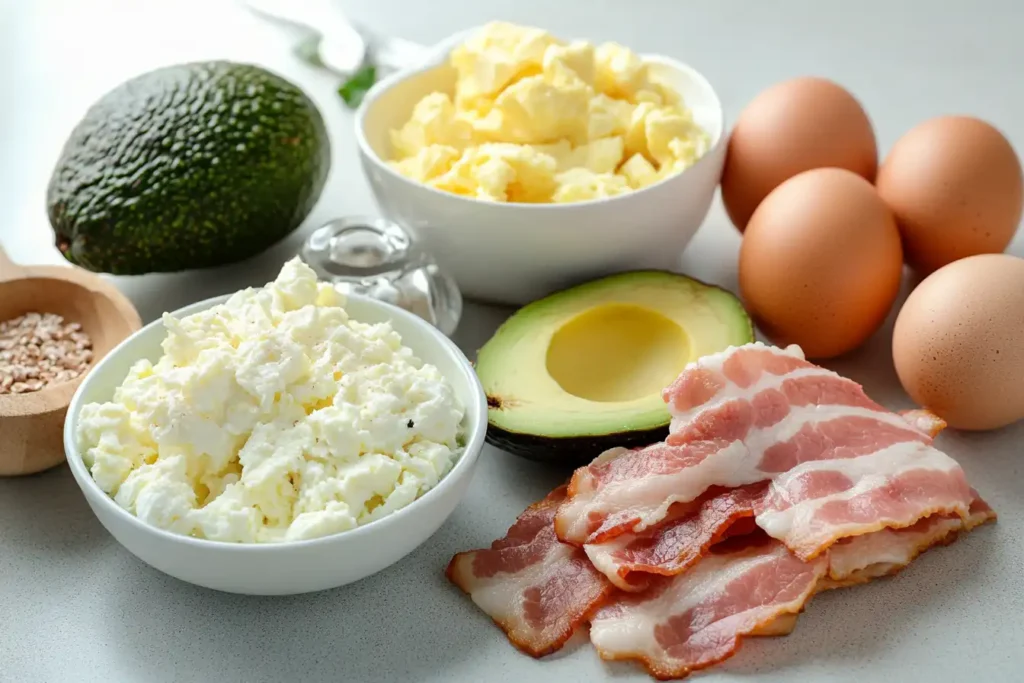
Now, let’s look at specific examples of keto meals you can prepare. These meals use the ingredients described above. The idea is to have a balanced nutritional intake while sticking to keto rules. These meals are designed to be satisfying and delicious. Also, they are meant to help you stay on track.
Breakfast Ideas for Typical Keto Meals
- Scrambled Eggs with Cheese and Avocado: This meal is quick and easy. It combines protein, fats, and nutrients. It is a great way to start the day. Also, it keeps you full for longer, which is essential for a keto diet.
- Bacon and Eggs: Classic Keto Breakfast: Classic keto breakfast. Use high-quality bacon and your choice of egg style. Therefore, this is a quick and satisfying option for keto.
- Keto Smoothie for a Quick Meal: Blend coconut milk, spinach, protein powder, and avocado. This is a great option if you want a faster breakfast. Furthermore, this is ideal for when you are short on time. Thus, you still get the benefits of keto even when busy.
Lunch Options for Your Keto Plan
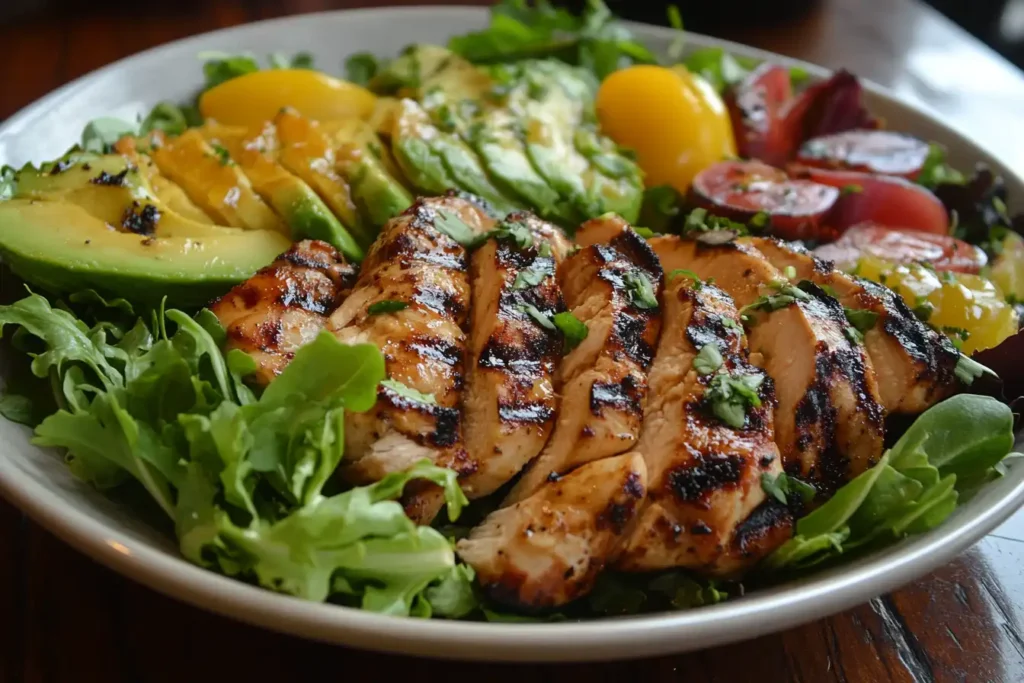
- Salad with Grilled Chicken or Salmon: A Keto Lunch Staple: Mix leafy greens, avocado, and low-carb vegetables. Top with your choice of grilled protein and a healthy dressing. Consequently, this is a light, but filling option for a keto lunch.
- Tuna Salad in Lettuce Wraps: Keto and Delicious: Combine tuna with mayonnaise, celery, and spices. Serve in lettuce cups instead of bread. Therefore, this is a healthy alternative to sandwiches, making it a great keto lunch option.
- Leftovers for Easy Keto Lunch: This saves time and ensures you are eating keto-friendly options. For example, you can use grilled chicken or roasted vegetables. Moreover, it’s great for managing your time and sticking to your keto plan.
Dinner Options on a Ketogenic Diet
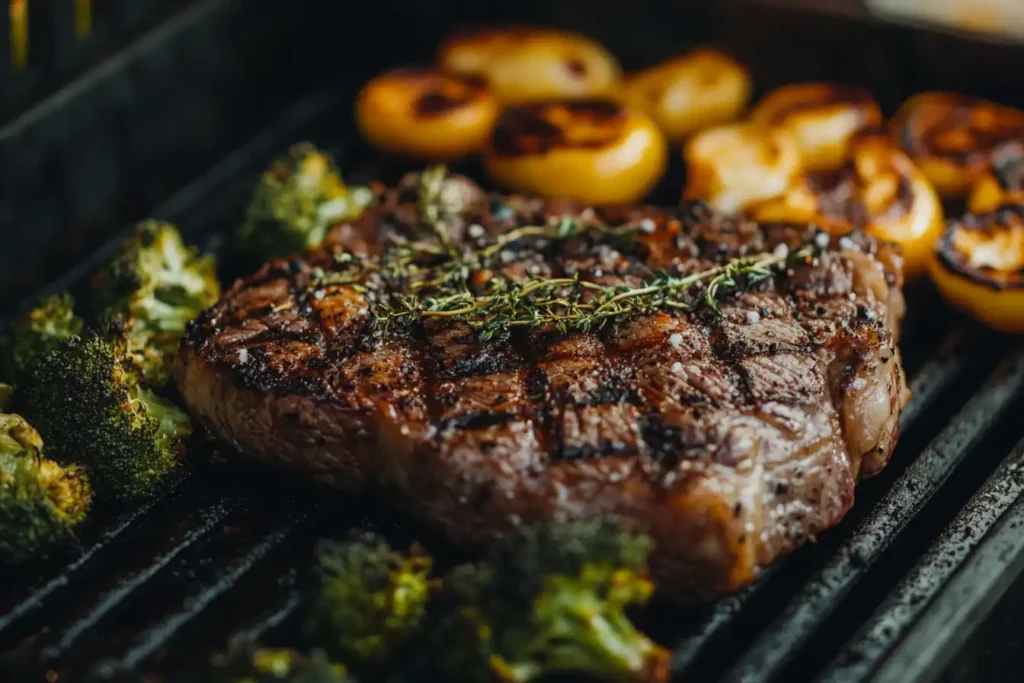
- Steak with Roasted Broccoli: A Simple Keto Dinner: A simple, but effective keto dinner. Protein from the steak and nutrients from the broccoli. Thus, this is a great way to end the day and adhere to keto.
- Salmon with Asparagus: A Healthy Keto Meal: Another great protein choice with a low-carb vegetable. Both are cooked together for ease. Indeed, these options are easy to prepare, making them keto friendly.
- Chicken Stir-Fry with Cauliflower Rice: Keto Dinner Made Easy: Use low-carb vegetables and protein. Serve over riced cauliflower instead of regular rice. This ensures a keto-compliant meal. Additionally, this is a great way to include different vegetables and stay keto.
Snack Ideas for Your Keto Journey
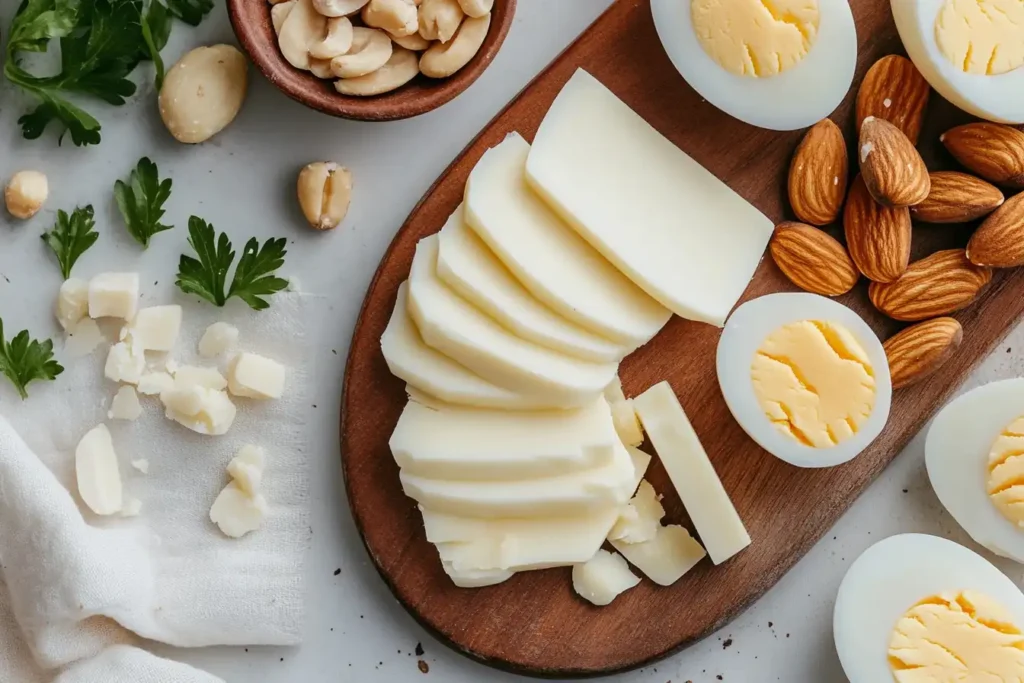
- Cheese Slices or Cubes: Keto Snack on the Go: An easy way to get some fats and protein between meals. Therefore, it is a convenient option for a quick snack for keto followers.
- A Handful of Nuts: Keto Friendly and Portable: A quick source of fats and protein. However, be careful with portion sizes. Also, they offer a good crunch, making them a nice keto snack.
- Hard-Boiled Eggs: Perfect Keto Snack: A portable snack with both protein and fats. Furthermore, these are easy to carry around, making them a great keto option.
The Importance of Hydration in a Keto Diet
Drinking enough water is very important on the keto diet. Therefore, stay hydrated with water throughout the day. This will help prevent dehydration and other problems. Water is essential for many bodily functions. Additionally, water helps with energy and digestion on keto.
Adjusting Keto Meals to Your Needs and Preferences
- Personal Taste and Keto Meals: Adjusting to Your Needs: Adjust keto meals to your preferences. Add seasoning and change ingredients as you like. Therefore, personalize your meals to be more enjoyable on keto.
- Allergies, Intolerances and Your Keto Diet: If you have food intolerances, choose compatible options. For example, if you cannot eat dairy, choose dairy-free fats. Consequently, it’s important to pay attention to your diet to manage any intolerances while on keto.
- Activity Levels and Your Keto Intake: If you exercise more, you may need to adjust your protein intake. Consider how your activity levels change your daily requirements. Also, more active people need more protein on keto.
Tips for Staying on Track with Your Keto Diet
- Plan Your Keto Meals in Advance: This helps you avoid unhealthy temptations. Having a meal plan makes it easier. Additionally, meal planning saves time, and is essential to a successful keto diet.
- Read Labels Carefully When Shopping for Keto Foods: Watch for hidden sugars and high-carb additives. Understanding food labels is very important. Therefore, it’s an essential skill for anyone on the keto diet.
- Prepare Keto Snacks to Stay Compliant: Keep keto-friendly snacks on hand. This can help you avoid reaching for unhealthy options when hungry. Furthermore, snacks keep you on track with keto.
Potential Benefits and Downsides of Keto
The keto diet may offer some benefits. Some people lose weight and experience better blood sugar control. However, some might have side effects. These include keto flu, constipation, and nutrient deficiencies. Therefore, it is important to carefully monitor your health. It is also key to stay balanced while on keto.
Keto for Vegetarians: A Flexible Approach
It is possible to do keto if you are vegetarian. Therefore, focus on protein from eggs, dairy, and plant-based sources. Include vegetables that are low in carbs. However, you need to pay more attention to your diet. Plant-based keto can require more planning, but is certainly flexible.
Planning Your Vegetarian Keto Meals
- Choose Eggs: A Great Source of Protein on Vegetarian Keto: Eggs are a great source of protein and fats. Therefore, these are very important for vegetarian keto. They are a quick and versatile option.
- Use Dairy: A Keto-Friendly Choice for Vegetarians: Cheese and full-fat dairy products are compatible. However, if you are vegan, you will need to use plant-based fats. It’s important to find substitutes that provide similar nutrients for vegetarian keto.
- Include Plant-Based Fats in Your Keto Plan: Avocados, nuts, and seeds are important sources of fats. Additionally, these offer fiber and other benefits, making them great for vegetarian keto.
- Use Low-Carb Vegetables on Vegetarian Keto: Make sure your diet contains a variety of low-carb vegetables. This will ensure a balanced diet while staying vegetarian keto. Furthermore, a diverse diet is crucial.
Keto and Long-Term Use: What to Know
Many people find that the keto diet works well for them. However, others may not find it suitable for long-term use. Therefore, talk to your doctor or a nutritionist. They can help you make sure you have the right nutrition. Professional guidance is always a good idea, especially for long term keto.
Consulting Health Professionals: Essential for Keto Success
- Talk to Your Doctor Before Starting Keto: It’s essential to discuss your plans with a doctor. This will help you understand any health concerns. They will monitor your progress and health while on keto.
- See a Dietitian for a Personalized Keto Plan: A dietitian can help create a plan that works for your requirements. They will give you more tailored advice for keto. Additionally, they can provide personalized meal plans.
Keto Meal Planning Tips: Making it Easy
- Start Simple with Your Keto Meals: Begin with a few easy recipes. As you get more comfortable, try more complex recipes. This makes the process less overwhelming. Also, it helps you stick to keto easier.
- Batch Cooking for Keto Convenience: Prepare large meals you can use over several days. This saves time and effort. Also, this helps you stay consistent on your keto diet.
- **Variety is Key to a Successful Keto Diet: Never eat the same meals all the time. Try new variations to keep things interesting. Indeed, a diverse diet is key for long-term success with keto.
Keto and Social Events: Navigating the Challenges
- Plan Ahead for Social Gatherings: If attending an event, plan your meals ahead of time. That way, you don’t have to choose between unhealthy options. Therefore, it is good to be prepared for social events while on keto.
- Bring Your Own Food to Stay Keto Compliant: If possible, take your own food. This is the easiest way to stay on track with your keto diet. Additionally, this ensures you always have keto-friendly options.
- Be Mindful When Choosing Keto Options at Events: Choose keto-friendly options at events, such as salads or grilled meats. Moreover, you can make smart choices with a bit of planning for social events and staying keto.
Keto and Exercise: Balancing Your Diet and Activity
- Adjust Your Keto Diet for Exercise: If you exercise regularly, adjust your protein and fat intake to support your needs. Furthermore, you might need extra protein when doing any type of physical activity while on keto.
- Consider Electrolytes While Exercising on Keto: Exercising can increase the need for electrolytes. Therefore, make sure to monitor your electrolyte intake while on keto.
- Listen to Your Body on Keto and Exercise: Pay attention to how your body feels before, during, and after exercise. This ensures you are meeting your nutritional requirements while on the keto diet and staying physically active.
Addressing the Keto Flu: Understanding and Managing
- What is the Keto Flu?: The “keto flu” is a group of symptoms some people experience when starting the diet. These are due to a shift in the body’s energy source. Also, this might include fatigue and headaches, however, it is temporary.
- How to Manage the Keto Flu: Tips and Tricks: Stay well hydrated, consume enough electrolytes, and be patient. The symptoms usually pass within a few days or weeks. Moreover, staying balanced and following a keto plan helps. Therefore, take extra care during the first few weeks.
Keto and Digestive Health: What to Consider
- Fiber Intake: Essential for Keto Digestion: Ensure you are getting enough fiber from low-carb vegetables and seeds. This can help prevent constipation. Therefore, fiber is important for digestive health on the keto diet.
- Probiotic Foods: Supporting Keto Digestion: Consider including probiotic-rich foods for a healthy digestive system. This also helps your body adjust to the keto diet, and improves your overall health.
- Monitor Your Body: Keeping Track of Your Keto Digestion: Pay attention to any signs of bloating or other digestive issues. Also, note what foods you are eating to track any sensitivities while on keto.
Keto and Budgeting: Making it Affordable
- Plan Your Shopping: Stay on Budget While on Keto: Make a shopping list to avoid impulse purchases. This helps you stick to your budget and keto plan. Thus, you can save money while on keto.
- Buy in Bulk: Cost-Effective Strategies for Keto: Purchasing staples in bulk can reduce your costs. Moreover, buying in larger quantities can save money on keto staples.
- Seasonal Produce: Saving Money on Keto Produce: Shop for produce that is in season. This often costs less and is more flavorful. Additionally, buying seasonal vegetables can save money when doing keto.
Keto and Traveling: Tips for Staying on Track
- Pack Your Own Snacks for Your Keto Trip: When traveling, pack keto-friendly snacks to avoid unhealthy choices on the go. Furthermore, this helps you maintain your diet when you are on the road, and on your keto diet.
- Research Restaurants Ahead of Time for Keto Options: Look up menus ahead of time to find restaurants with keto options. Also, you can make informed choices when eating out and staying keto.
- Stay Prepared for Any Keto Traveling Trip: Have a plan for how you will manage your keto diet while traveling. This will help you stay on track. Therefore, plan to stay successful with your keto diet.
Keto and Sweet Cravings: Finding Satisfying Options
- Sugar Alternatives: Managing Sweet Cravings on Keto: Use sugar alternatives like stevia or erythritol in small amounts. This can help with cravings. However, do so in moderation, and it will help satisfy any sweet cravings.
- Low-Carb Treats: Keto-Friendly Sweet Options: Enjoy low-carb options like dark chocolate in small portions. Moreover, this can satisfy your sweet tooth without breaking your keto diet.
- Be Patient: Reducing Your Sweet Cravings on Keto: Allow your body to adjust to fewer sugars. The cravings will reduce over time. Therefore, stay focused on the long-term goal of your keto diet.
Frequently Asked Questions (FAQs):
What are some typical keto meals?
Typical keto meals focus on high-fat, moderate-protein, and very low-carbohydrate ingredients. Examples include scrambled eggs with cheese and avocado, grilled salmon with asparagus, steak with roasted broccoli, and salads with grilled chicken. Snacks can be cheese slices, nuts, or hard-boiled eggs.
What is the most filling food on keto?
Foods that are high in both protein and healthy fats are the most filling on the keto diet. These include eggs, meats like beef and chicken, fish like salmon, avocados, and nuts. These will help you feel full and satisfied. Therefore, combine protein and fats for best results.
How fast to lose 20 pounds on keto?
Weight loss on keto varies from person to person. Some may see rapid weight loss initially, especially water weight. However, it’s not always consistent. How quickly you lose 20 pounds depends on factors such as your starting weight, diet adherence, and exercise. It could take anywhere from a few weeks to a few months.
What are the 9 rules of keto?
The “9 rules of keto” aren’t a set in stone list, but generally include: 1. Limit carbohydrates to around 20-50 grams per day. 2. Eat moderate amounts of protein. 3. Get a high percentage of your daily calories from healthy fats. 4. Drink plenty of water. 5. Avoid sugary drinks and processed foods. 6. Eat plenty of low-carb vegetables. 7. Monitor your electrolyte intake. 8. Track your macros. 9. Be consistent and patient.
Conclusion
Typical keto meals focus on high-fat, moderate-protein, and very low-carbohydrate ingredients. You can enjoy a variety of meals while following keto. It’s also important to understand how keto fits your personal health. Therefore, always consult with your health professional before changing to any new diet plan. This helps ensure a safe and effective plan. With the right approach, you can have satisfying keto meals and reach your goals. Furthermore, by planning and preparing your meals, you can be successful on the keto diet.

